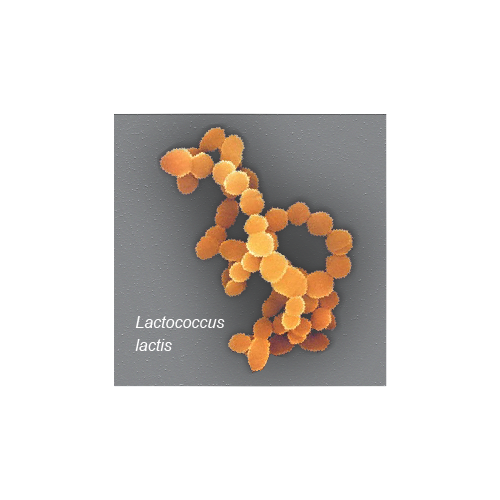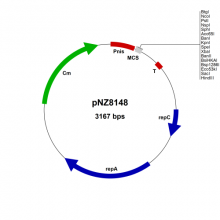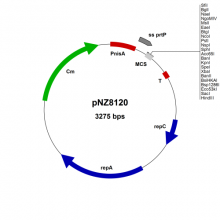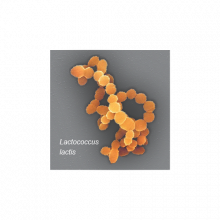
NICE® Lactococcus lactis Host Strain
The Nisin controlled gene expression system (NICE®), developed at NIZO Food Research, NL, is a fully food-grade system used for controlled gene expression in Lactococcus lactis. The NICE® system is advantageous in that it does not contain endotoxins, inclusion bodies, spores or extracellular proteases, and the tightly controlled gene expression allows the production of toxic proteins to take place. With this system, fermentation, scale-up and downstream processing are simple.
The NICE® system provides multiple host strains. All strains are derivatives of L. lactis subsp. cremoris MG1363, a plasmid-free progeny of the dairy starter strain NCDO712.
Strains:
- NZ9000 (ELS09000-01) – pepn:: nisRK; standard host strain for nisin regulated gene expression. The strain contains the regulatory genes nisR and nisK integrated into the pepn gene (broad range amino peptidase).
- NZ9100 (ELS09100) – nisRK; standard host strain for nisin regulated gene expression. The strain contains the regulatory genes nisR and nisK integrated in a neutral locus.
- NZ3900 (ELS03900-01) – lacF-, pepn:: nisRK; standard strain for food grade selection based on the ability to grow on lactose. This strain is a progeny of NZ3000, a strain in which the lactose operon that is generally present on plasmids has been integrated into the chromosome and the lacF gene was deleted. Deletion of the lacF gene makes this strain unable to grow on lactose unless lacF is provided on a plasmid.
- NZ3910 (ELS03910-01) – lacf-, nisRK; same as NZ3900 for food grade lacF selection, but with nisRnisK integrated in a neutral locus.
- NZ9130 (ELS09130-01) – alr-, nisRK; This strain is the same as N9100 used for nisin regulated gene expression. It carries an alr deletion (Δalr) that encodes for alanine racemase. Deletion of the alr gene results in auxotrophy for D-alanine, suggesting that the strain is unable to grow on media without alanine unless alr is provided on a plasmid. The alr gene serves here as food grade complementation marker.
- Endotoxin-free, food-grade expression system
- Expression of membrane proteins
- Secretion of proteins into the medium
- Fewer endogenous and no exogenous proteases
- No spores or inclusion bodies
- Tightly controlled gene expression allows production of toxic proteins
- Simple fermentation, scale-up and downstream processing
- Production of homologous and heterologous proteins for food, feed, pharmacological and biocatalysis applications
- Production of prokaryotic and eukaryotic membrane proteins
- Production of exopolysaccharides
- Production of ingredients through metabolic engineering: e.g. alanine, folate, diacetyl
- Preparation of L. lactis as a biocatalyst by expression of a suitable enzyme as, e.g., dehydrogenases and in-situ cofactor regeneration
- High-throughput screening for enzyme evolution or enzyme comparison
Boca Scientific is your premiere source for high-quality, innovative solutions for Cell Biology, Molecular Biology, Immunology, genetics and other lab products and reagents. We bring leading-edge products from our own-line and around the world to laboratories in the US and Canada. Our goal is to offer excellent solutions to drive research and discoveries backed by superior customer support.

 NICE® Lactococcus lactis Expression Vector
NICE® Lactococcus lactis Expression Vector NICE® Lactococcus lactis Secretion Vector
NICE® Lactococcus lactis Secretion Vector